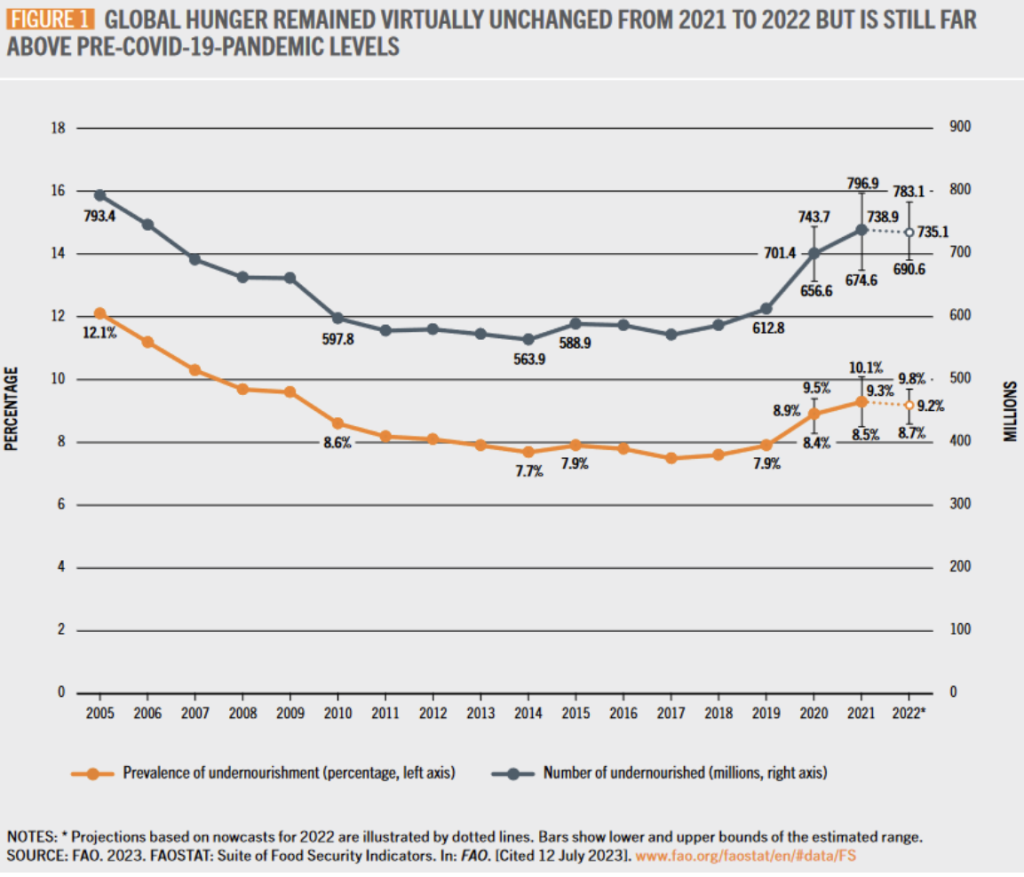
The State of Food Security and Nutrition in the World (SOFI – 2023)
New estimates indicate hunger is no longer on the rise at the global level but is still far above pre-COVID-19-pandemic levels and far off track to achieve SDG 2.
After presenting the latest updates of the food security and nutrition situation around the world, the report then examines the drivers, patterns and dynamics of urbanization through a rural–urban continuum lens and presents new analysis on how urbanization is changing food supply and demand across the rural–urban continuum. Further analyses for selected countries explore differences in the cost and affordability of a healthy diet, and in food insecurity and different forms of malnutrition across the rural–urban continuum.
Building on these insights, the report identifies policies, investments and new technologies to address the challenges, and capitalize on the opportunities, that urbanization brings for ensuring access to affordable healthy diets for everyone, across the rural–urban continuum.
The State of Food Security and Nutrition in the World (SOFI – 2022)
The most recent evidence available suggests that the number of people unable to afford a healthy diet around the world rose by 112 million to almost 3.1 billion, reflecting the impacts of rising consumer food prices during the pandemic.
This report repeatedly highlights the intensification of these major drivers of food insecurity and malnutrition: conflict, climate extremes and economic shocks, combined with growing inequalities.
Governments’ support to food and agriculture accounts for almost USD 630 billion per year globally. However, a significant proportion of this support distorts market prices, is environmentally destructive, and hurts small-scale producers and Indigenous Peoples, while failing to deliver healthy diets to children and others who need them the most. The evidence suggests that if governments repurpose the resources to prioritize food consumers, and to incentivize sustainable production, supply and consumption of nutritious foods, they will help make healthy diets less costly and more affordable for all.
The State of Food Security and Nutrition in the World (SOFI - 2021)
In recent years, several major drivers have put the world off track to ending world hunger and malnutrition in all its forms by 2030. This report presents the first global assessment of food insecurity and malnutrition for 2020 and offers some indication of what hunger might look like by 2030 in a scenario further complicated by the enduring effects of the COVID-19 pandemic. It also includes new estimates of the cost and affordability of healthy diets, which provide an important link between the food security and nutrition indicators and the analysis of their trends.
The State of Food Security and Nutrition in the World (SOFI - 2020)
The thematic focus of the 2020 edition of the SOFI is the relationship between food systems, unhealthy diets, food insecurity and malnutrition. The 2020 SOFI report contains critical data updates for China that have led to a substantial cut in estimates of the global number of hungry people, to the current 690 million. Nevertheless, the global figure of chronic hunger is still on the rise since 2014 and continues to do so.
The State of Food Security and Nutrition in the World (SOFI - 2019)
More than 820 million people in the world were still hungry in 2018, and hunger is on the rise in Africa, Latin America and the Caribbean, and Western Asia. This edition presents an in-depth analysis of the impacts of economic slowdowns and downturns on food security and nutrition.
The State of Food Security and Nutrition in the World (SOFI - 2018)
For the third year in a row, there has been a rise in world hunger. The absolute number of undernourished people, i.e. those facing chronic food deprivation, has increased to nearly 821 million in 2017, from around 804 million in 2016. These are levels from almost a decade ago.
The State of Food Security and Nutrition in the World (SOFI - 2017)
There is more than enough food produced in the world to feed everyone, yet 815 million people go hungry. As reflected in Sustainable Development Goal 2, one of the greatest challenges the world faces is how to ensure that a growing global population has enough food to meet their nutritional needs. Food security is a complex condition requiring a holistic approach to all forms of malnutrition, the productivity and incomes of small-scale food producers, resilience of food production systems and the sustainable use of biodiversity and genetic resources.
| Originally Published | Last Updated | 26 Aug 2019 | 09 Aug 2023 |
| Related organisation(s) | FAO - Food and Agriculture Organization of the United NationsWFP - World Food ProgrammeWHO - World Health OrganisationUNICEF - United Nations Children's FundIFAD - International Fund for Agricultural Development |
| Knowledge service | Metadata | Global Food and Nutrition Security | Food security and food crisesAgroecologyClimate extremes and food security Nutrition |
| Digital Europa Thesaurus (DET) | AgricultureFoodfood securitymalnutritionnutritionsustainable development |
